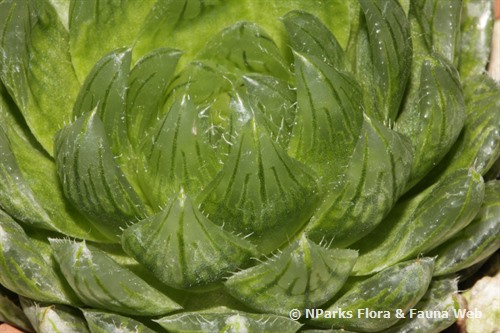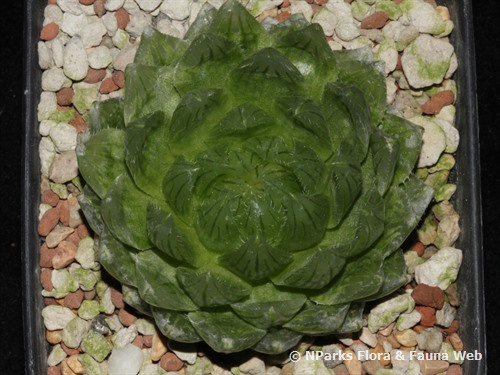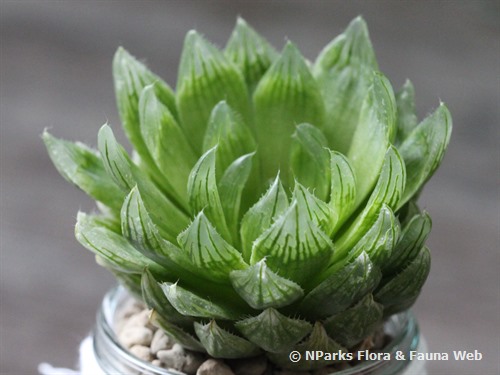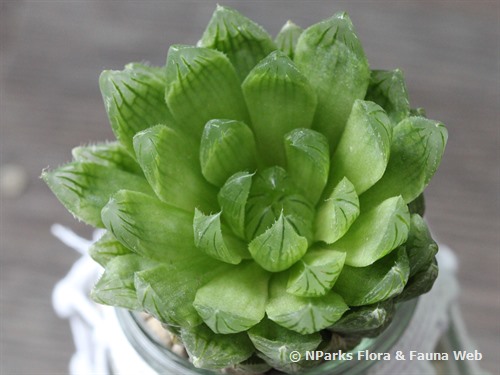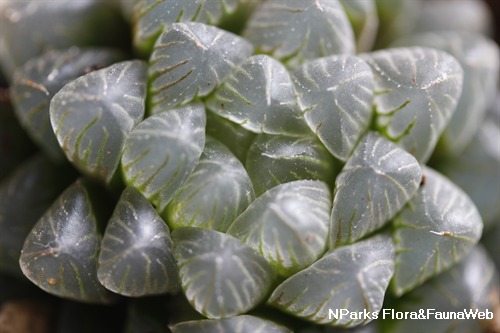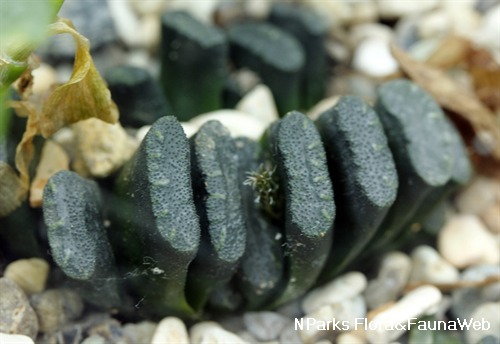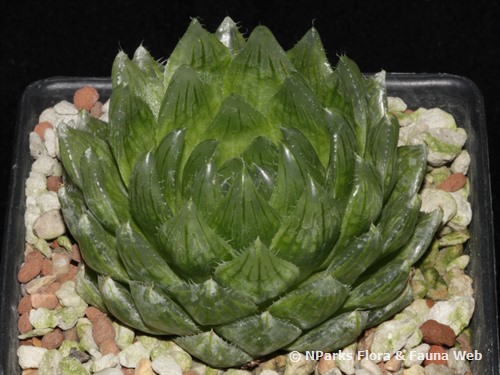
Name
Classifications and Characteristics
| Plant Division | Angiosperms (Flowering Seed Plants) |
|---|---|
| Plant Growth Form | Succulent Plant |
| Lifespan (in Singapore) | Perennial |
| Mode of Nutrition | Autotrophic |
Biogeography
| Native Distribution | Of horticultural origin. |
|---|
Description and Ethnobotany
| Growth Form | Rosette-forming succulent up to about 8 cm tall. |
|---|---|
| Foliage | Thick, triangular leaves are tightly arranged in a rosette. Light green, translucent leaves are smooth and glossy, streaked with dark green markings. Young leaves are more erect compared to the outer, older leaves which are ascending. |
| Stems | This plant lacks a stem. |
| Flowers | White, 2-lipped tubular flowers with brownish longitudinal stripes are arranged near the tip of a spike inflorescence. The inflorescence stalk is sparsely lined with triangular leafy bracts and much taller than the plant. |
| Fruit | The dry, dehiscent fruit is known as a capsule. |
| Cultivation | Haworthia obtusa 'LED' grows very slowly, but is easy to care for. It requires well-drained soil and bright, but indirect light. It is drought tolerant and handles underwatering well, but quickly rots when overwatered. In an air-conditioned environment, it should be watered once every 2 weeks or more. |
Landscaping Features
| Desirable Plant Features | Ornamental Foliage, Ornamental Form |
|---|---|
| Landscape Uses | Interiorscape/ Indoor Plant, Container Planting |
| Thematic Landscaping | Rockery / Desert Garden |
Plant Care and Propagation
| Light Preference | Semi-Shade |
|---|---|
| Water Preference | Little Water |
| Rootzone Tolerance | Drought Tolerant, Well-Drained Soils, Easy to Grow |
| Maintenance Requirements | Low |
| Fertilizing | Feed with half-strength fertilizer every 1-2 months. |
| Propagation Method | Leaf Cutting |
| Plant Growth Rate Remarks | very slow-growing |
| Propagation Method Remarks | This plant produces small plantlets near the base which are called offsets. They can be removed from the mother plant with a knife, being sure to include some roots in the cutting. Plants require cross pollination for successful fertilization and production of viable seed. |
Foliar
| Mature Foliage Colour(s) | Green, Green - Light Green, Patterned |
|---|---|
| Mature Foliage Texture(s) | Smooth, Thick |
| Young Flush Texture(s) | Smooth |
| Foliar Type | Simple / Unifoliate |
| Foliar Attachment to Stem | Sessile |
| Foliar Shape(s) | Non-Palm Foliage (Deltoid) |
| Foliar Venation | Reticulate |
| Foliar Margin | Entire |
| Foliar Apex - Tip | Acute |
| Foliar Base | Truncate / Square |
Floral (Angiosperm)
| Flower Texture(s) | Smooth |
|---|---|
| Flower Grouping | Cluster / Inflorescence |
| Flower Location | Terminal |
| Flower Symmetry | Bilateral |
| Individual Flower Shape | Tubular |
| Inflorescence Type | Spike |
Image Repository
Others
| Master ID | 32958 |
|---|---|
| Species ID | 7372 |
| Flora Disclaimer | The information in this website has been compiled from reliable sources, such as reference works on medicinal plants. It is not a substitute for medical advice or treatment and NParks does not purport to provide any medical advice. Readers should always consult his/her physician before using or consuming a plant for medicinal purposes. |

